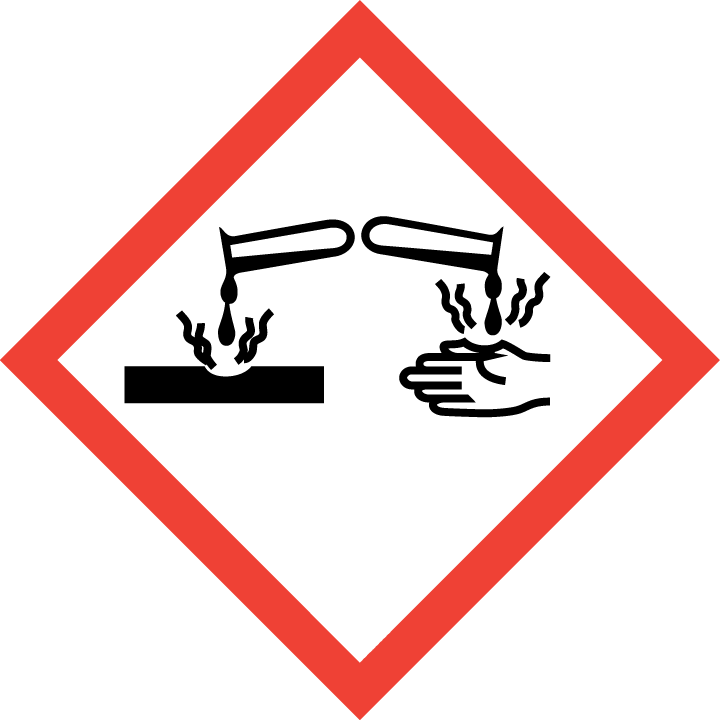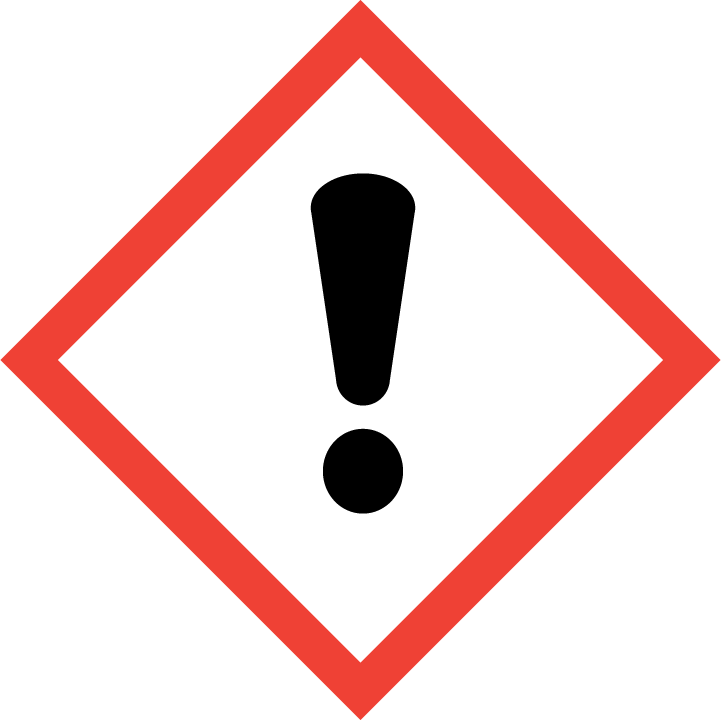SAFETY DATA SHEET
Safranin O Solution, 0.1%
1. IDENTIFICATION
Product Identifiers
Product Name:
Safranin O Solution, 0.1%
Other Names:
Nil
Product Number(s):
26481-07, 26758-05, EMS26481-07
CAS Number:
477-73-6
Recommended use of the chemical and restriction on use
Laboratory use. Stains
Company Details
ProSciTech Pty Ltd
11 Carlton Street
KIRWAN QLD 4817
Australia(07) 4773 9444www.proscitech.com
11 Carlton Street
KIRWAN QLD 4817
Australia(07) 4773 9444www.proscitech.com
Emergency Contact Details
ProSciTech Pty Ltd
11 Carlton Street
KIRWAN QLD 4817
Australia(07) 4773 9444www.proscitech.com
11 Carlton Street
KIRWAN QLD 4817
Australia(07) 4773 9444www.proscitech.com
2. HAZARDS IDENTIFICATION
Classification of the substance or mixture
GHS05 Corrosion
Corrosive to metals 1 H290 May be corrosive to metals.
GHS07
Acute toxicity - oral 4 H302 Harmful if swallowed.
Skin irritation 2 H315 Causes skin irritation.
Eye irritation 2A H319 Causes serious eye irritation.
Corrosive to metals 1 H290 May be corrosive to metals.
GHS07
Acute toxicity - oral 4 H302 Harmful if swallowed.
Skin irritation 2 H315 Causes skin irritation.
Eye irritation 2A H319 Causes serious eye irritation.
Label Elements


Signal Words
Warning
Hazard Statement(s)
May be corrosive to metals.
Harmful if swallowed.
Causes skin irritation.
Causes serious eye irritation.
Harmful if swallowed.
Causes skin irritation.
Causes serious eye irritation.
Precautionary Statement(s)
Keep only in original packaging.
Wash thoroughly after handling.
Do not eat, drink or smoke when using this product.
Wear protective gloves / eye protection / face protection
Wash thoroughly after handling.
Do not eat, drink or smoke when using this product.
Wear protective gloves / eye protection / face protection
Primary route(s) of entry
Not availalble
Human Health
Inhalation:
Ingestion:
Call a poison center/doctor if you feel unwell.
Rinse mouth
Rinse mouth
Eyes:
Rinse cautiously with water for several minutes. Remove contact lenses, if present and easy to do.
Continue rinsing.
If eye irritation persists: Get medical advice/attention.
Continue rinsing.
If eye irritation persists: Get medical advice/attention.
Skin:
Wash with plenty of water.
If skin irritation occurs: Get medical advice/attention.
Take off contaminated clothing and wash it before reuse.
If skin irritation occurs: Get medical advice/attention.
Take off contaminated clothing and wash it before reuse.
Environment
Absorb spillage to prevent material damage.
Store in a corrosion resistant container / container with a resistant inner liner.
Dispose of contents/container in accordance with local/regional/national/international regulations.
Store in a corrosion resistant container / container with a resistant inner liner.
Dispose of contents/container in accordance with local/regional/national/international regulations.
3. COMPOSITION/INFORMATION ON INGREDIENTS
No information available.
4. FIRST AID MEASURES
Ingestion
Immediately call a doctor.
Inhalation
In case of unconsciousness place patient stably in side position for transportation.
Skin Contact
Immediately wash with water and soap and rinse thoroughly.
Eye Contact
Rinse opened eye for several minutes under running water. If symptoms persist, consult a doctor
Other Information
General information:
Symptoms of poisoning may even occur after several hours; therefore medical observation for at least 48 hours
after the accident.
Most important symptoms and effects, both acute and delayed: No further relevant information available.
Indication of any immediate medical attention and special treatment needed: No further relevant information available.
Symptoms of poisoning may even occur after several hours; therefore medical observation for at least 48 hours
after the accident.
Most important symptoms and effects, both acute and delayed: No further relevant information available.
Indication of any immediate medical attention and special treatment needed: No further relevant information available.
5. FIREFIGHTING MEASURES
Suitable extinguishing equipment
Use fire fighting measures that suit the environment.
HAZCHEM
No further relevant information available.
Special protective equipment and precautions for fire fighters
6. ACCIDENTAL RELEASE MEASURES
Personal precautions, protective equipment and emergency procedures
Not required.
Environmental precautions
Dilute with plenty of water
Methods and materials for containment and clean up
Absorb with liquid-binding material (sand, diatomite, acid binders, universal binders, sawdust).
Dispose contaminated material as waste according to section 13.
Ensure adequate ventilation.
Dispose contaminated material as waste according to section 13.
Ensure adequate ventilation.
7. HANDLING AND STORAGE
Precautions for safe handling
Ensure good ventilation/exhaustion at the workplace.
Prevent formation of aerosols.
· Information about protection against explosions and fires: No special measures required.
Prevent formation of aerosols.
· Information about protection against explosions and fires: No special measures required.
Conditions for safe storage
· Information about storage in one common storage facility: Not required.
· Further information about storage conditions: Keep receptacle tightly sealed.
· Specific end use(s) No further relevant information available.
8. EXPOSURE CONTROLS/PERSONAL PROTECTION
Exposure Standards
Engineering controls
Control parameters
· Components with limit values that require monitoring at the workplace: Not required.
· Additional information: The lists that were valid during the creation were used as basis.
· Appropriate engineering controls: No further data; see section 7.
· Components with limit values that require monitoring at the workplace: Not required.
· Additional information: The lists that were valid during the creation were used as basis.
· Appropriate engineering controls: No further data; see section 7.
Personal protective equipment
Eye and face protection
Tightly sealed goggles
Skin protection
Protective gloves
The glove material has to be impermeable and resistant to the product/ the substance/ the preparation.
Due to missing tests no recommendation to the glove material can be given for the product/ the preparation/ the
chemical mixture.
Selection of the glove material on consideration of the penetration times, rates of diffusion and the degradation
· Material of gloves
The selection of the suitable gloves does not only depend on the material, but also on further marks of quality and
varies from manufacturer to manufacturer.
· Penetration time of glove material
The exact break through time has to be found out by the manufacturer of the protective gloves and has to be
observed.
The glove material has to be impermeable and resistant to the product/ the substance/ the preparation.
Due to missing tests no recommendation to the glove material can be given for the product/ the preparation/ the
chemical mixture.
Selection of the glove material on consideration of the penetration times, rates of diffusion and the degradation
· Material of gloves
The selection of the suitable gloves does not only depend on the material, but also on further marks of quality and
varies from manufacturer to manufacturer.
· Penetration time of glove material
The exact break through time has to be found out by the manufacturer of the protective gloves and has to be
observed.
Body protection
Keep away from foodstuffs, beverages and feed.
Immediately remove all soiled and contaminated clothing.
Wash hands before breaks and at the end of work.
Immediately remove all soiled and contaminated clothing.
Wash hands before breaks and at the end of work.
Respiratory protection
Breathing equipment:
In case of brief exposure or low pollution use respiratory filter device. In case of intensive or longer exposure use
respiratory protective device that is independent of circulating air.
In case of brief exposure or low pollution use respiratory filter device. In case of intensive or longer exposure use
respiratory protective device that is independent of circulating air.
9. PHYSICAL AND CHEMICAL PROPERTIES
General information
Appearance
Liquid
Odour
Characteristic
pH
Mixture is non-polar/aprotic.
Vapour Pressure
at 20 °C (68 °F): 23 hPa (17.3 mm Hg)
Density
at 20 °C (68 °F): 1.00001 g/cm³ (8.34508 lbs/gal)
Boiling Point
100 °C (212 °F)
Melting Point
0 °C (32 °F)
Solubility
Fully miscible
Specific Gravity of Density
Not determined.
Flash Point
Not applicable
Flammable (Explosive) Limits
Product does not present an explosion hazard.
Ignition Temperature
Not determined.
Formula
C20H19ClN4 for the dye component.
10. STABILITY AND REACTIVITY
Reactivity
No further relevant information available.
Chemical stability
Thermal decomposition / conditions to be avoided: No decomposition if used according to specifications.
Possibility of hazardous reactions
No dangerous reactions known.
Conditions to avoid
No further relevant information available.
Incompatible materials
No further relevant information available.
11. TOXICOLOGICAL INFORMATION
Acute effects
No further relevant information available.
Eye contact
Irritating effect.
Skin contact
Irritant to skin and mucous membranes
Ingestion
No further relevant information available.
Inhalation
No further relevant information available.
Toxicity and irritation
No interactive effects between components are known.
12. ECOLOGICAL INFORMATION
Ecotoxicity
No further relevant information available
Persistence and degradability
No further relevant information available
Bioaccumulative potential
No further relevant information available
Other adverse effects
No further relevant information available
13. DISPOSAL CONSIDERATIONS
General information
· Waste treatment methods
· Recommendation:
Must not be disposed of together with household garbage. Do not allow product to reach sewage system.
· Uncleaned packagings:
· Recommendation: Disposal must be made according to official regulations.
· Recommended cleansing agent: Water, if necessary with cleansing agents.
· Recommendation:
Must not be disposed of together with household garbage. Do not allow product to reach sewage system.
· Uncleaned packagings:
· Recommendation: Disposal must be made according to official regulations.
· Recommended cleansing agent: Water, if necessary with cleansing agents.
14. TRANSPORT INFORMATION
ADG label required
HAZCHEM
No further relevant information available.
UN Number
Void
Proper shipping name
Void
Transport hazard class
Void
Packing group
Void
Environmental hazard
Not applicable
Special precautions for users
Not applicable
Additional information
Not applicable
15. REGULATORY INFORMATION
Poisons Schedule Number
No further relevant information available.
Other Information
No further relevant information available.
16. OTHER INFORMATION
SDS preparation date
22 October 2025
Comments
· Abbreviations and acronyms:
ADR: Accord relatif au transport international des marchandises dangereuses par route (European Agreement Concerning the International
Carriage of Dangerous Goods by Road)
IMDG: International Maritime Code for Dangerous Goods
DOT: US Department of Transportation
IATA: International Air Transport Association
EINECS: European Inventory of Existing Commercial Chemical Substances
CAS: Chemical Abstracts Service (division of the American Chemical Society)
NFPA: National Fire Protection Association (USA)
HMIS: Hazardous Materials Identification System (USA)
VOC: Volatile Organic Compounds (USA, EU)
PBT: Persistent, Bioaccumulative and Toxic
vPvB: very Persistent and very Bioaccumulative
NIOSH: National Institute for Occupational Safety
OSHA: Occupational Safety Health
TLV: Threshold Limit Value
PEL: Permissible Exposure Limit
REL: Recommended Exposure Limit
Corrosive to metals 1: Corrosive to metals - Category 1
Acute toxicity - oral 4: Acute toxicity - Category 4
Skin irritation 2: Skin corrosion/irritation - Category 2
Eye irritation 2A: Serious eye damage/eye irritation - Category 2A
ADR: Accord relatif au transport international des marchandises dangereuses par route (European Agreement Concerning the International
Carriage of Dangerous Goods by Road)
IMDG: International Maritime Code for Dangerous Goods
DOT: US Department of Transportation
IATA: International Air Transport Association
EINECS: European Inventory of Existing Commercial Chemical Substances
CAS: Chemical Abstracts Service (division of the American Chemical Society)
NFPA: National Fire Protection Association (USA)
HMIS: Hazardous Materials Identification System (USA)
VOC: Volatile Organic Compounds (USA, EU)
PBT: Persistent, Bioaccumulative and Toxic
vPvB: very Persistent and very Bioaccumulative
NIOSH: National Institute for Occupational Safety
OSHA: Occupational Safety Health
TLV: Threshold Limit Value
PEL: Permissible Exposure Limit
REL: Recommended Exposure Limit
Corrosive to metals 1: Corrosive to metals - Category 1
Acute toxicity - oral 4: Acute toxicity - Category 4
Skin irritation 2: Skin corrosion/irritation - Category 2
Eye irritation 2A: Serious eye damage/eye irritation - Category 2A
References
EMS SDS SAFRANIN O SOLUTION, 0.1%. https://www.emsdiasum.com/docs/technical/msds/26481-07.pdf 15/11/2022
This Safety Data Sheet (SDS) has been prepared in compliance with the Preparation of Safety Data Sheets for Hazardous Chemicals Code of Practice February 2016. It is the user's responsibility to determine the suitability of this information for adoption of necessary safety precautions. The information published in this SDS has been compiled from the publications listed in Section 16: to the best of our ability and knowledge these publications are considered accurate. We reserve the right to revise Safety Data Sheets as new information becomes available. Copies may be made for non-profit use.